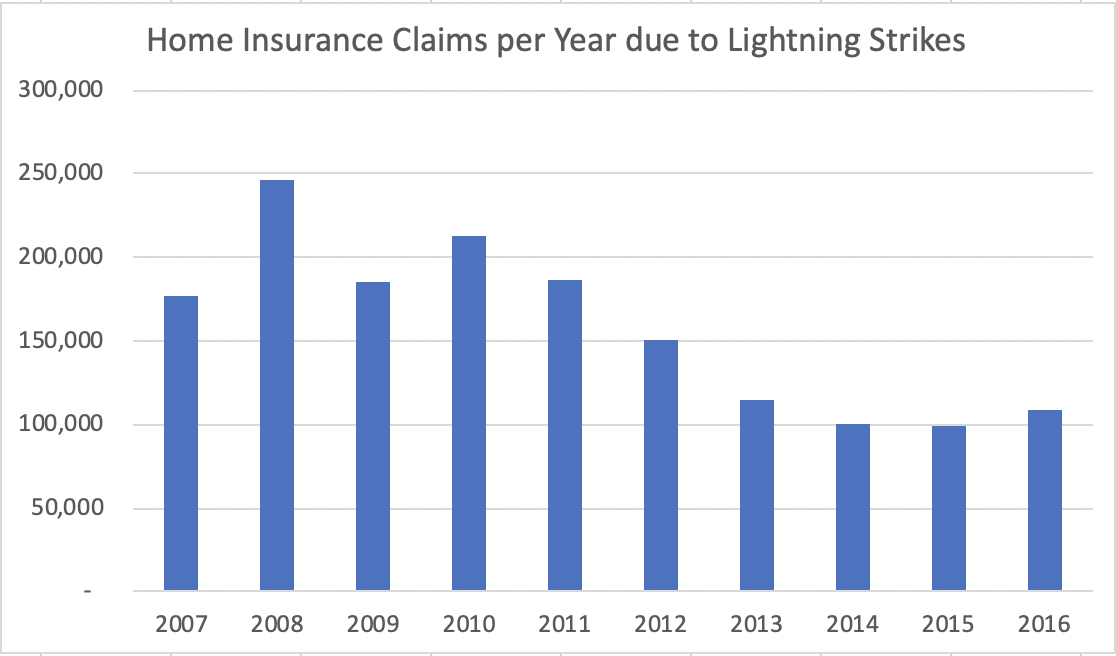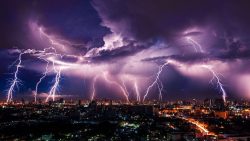When lightning bolts shatter the night sky with flashes of light and the thunder booms, I often find myself wondering “do we need a lightning rod on our house? I suspect many others that live in areas prone to thunder and lightning storms ask themselves the same question. Therefore, we decided to look into thunder and lightning storms and provide some helpful information to everyone in this situation.
First, get a free rating on your insurance companies. All car drivers and homeowners should know how good their insurance is. It’s true, not all insurance is created equal.
What’s the frequency of lightning storms?
On average, lightning strikes result in 100,000 to 200,000 home insurance claims per year. The cost of these insurance claims total around one billion dollars per year. See the chart below using data from the Insurance Information Institute showing a ten-year trend in homeowners insurance claims due to lightning.

In terms of frequency, home insurance claims due to lightning strikes is much less than claims for wind, hail or water damage. However, in terms of the average cost per claim, the damage done is similar to these other, more frequent hazards.
Do I need a lightning rod to protect my home?
Most residential homes don’t need lightning protection. However, if you have the following conditions then a lightning rod and lightning protection makes sense:
- You live in an area with a high frequency of lightning strikes
- The home is tall
- There are trees taller than the home within ten feet of the home
How does a lightning rod protect a home?
It’s not possible to prevent homes from being struck by lighting. Also, it’s important to understand that lightning rods are one component of a more complete lightning protection system. The objective of a lightning protection system is to intercept the high-voltage electrical energy and route it to ground while bypassing the home. Full lightning protection systems include surge protection to protect devices within the home.
The term lightning rod is a reference to a copper rod mounted on or near the home. The objective of this copper rod is to provide the least resistance path to ground. Electricity seeks that least resistance path to ground. Hence, the lightning rod can divert energy from the atmosphere to ground.
If you need a lightning protection system, contract with someone who specializes in installing such systems.
ValChoice recommends consumers make sure they’re well protected by buying insurance from the best insurance companies. ValChoice rates every home and auto insurance company, in every state where they do business. Click the buttons below to find the best companies in your state.
Protecting Yourself in a Lightning Storm
When you hear thunder, lightning is nearby. There are steps you can take to protect yourself and your home from a lightning strike. Let’s start with your body, then we will cover your home and possessions.
- Go inside. Make sure you are inside a solid structure or an automobile with a hard top.
- Don’t ever be the tallest object around, or close to the tallest object. If caught in a field where you are the tallest object, get to a low area, crouch down –don’t lay down — and have minimal contact with the ground. The less contact you have with the ground the more difficult it is for the electricity to pass through you to the ground, making you a less attractive object to strike.
- Avoid tall objects or metal objects. Don’t take shelter under a tree or near a metal fence. Objects that are tall, or objects that are good for conducting electricity will attract lightning. Stay away from them.
- Inside your home, stay away from anything connected with wires or piping (TVs, lights, appliances, faucets, etc.). If lightning strikes the home the conductive properties of wires and plumbing will bring it to you.
Preparing Your Home for a Lightning Strike
Protecting your home and possessions from damage from a lightning strike varies from simple and inexpensive to elaborate and expensive. Let’s start with the simple and inexpensive actions you can take.
Items You Can Easily Address Yourself
- Install UL listed surge protectors. These need to be specially designed for electrical strikes. Don’t use power strips as protective devices. Most are not designed for reliable lightning strike protection.
- Unplug expensive electronics. If you are going to be gone for a while, unplug the computer, TV, etc. before you leave. If a storm is approaching, unplug the devices temporarily. House wiring is a direct path from the lightning strike to these devices. If they are unplugged, that is the best form of surge protection.
Items With Which You May Need A Professional Help
- Pay special attention to wires and plumbing that enter the home. Since wires and plumbing external to the home are often exposed, they are an easy path for lightning to strike, then have a direct path into your home. These are relatively easy pathways to protect with special devices that act as a shunt to ground and are installed where your service enters the home. A good electrician should know what protective devices to use and how to install them.
- Protect gas plumbing inside the home with proper grounding. Black iron pipe is relatively safe, but many newer homes were built using Corrugated Stainless Steel Tubing (CSST) for gas lines. This tubing has the advantage of being easy to install. Unfortunately it has the disadvantage of being prone to puncture, and resulting gas leaks, in electrical storms. Make sure any CSST in your home is properly grounded. Main lines that carry gas from outside the home back to a distribution point (also often the grounding location) may make sense and be an inexpensive precaution.
- Protect the structure with a lightning protection system. The idea of these systems is to divert the electrical energy of a lightning strike to the ground, protecting both the structure and the contents. This is obviously the best solution, but also something that requires professional design and installation. Lightening is unpredictable so a simple lightning rod is inadequate. A professional at designing these systems will know how to protect the home no matter where lightening strikes.
ValChoice as a Resource
ValChoice is here to help consumers. Use our free ratings regularly to make sure you’re insured by companies that will stand behind you when you file a claim. Use our lists of best companies to find better insurance when you shop for insurance. Also, we even have insurance price calculators. Find a fair price for your insurance with our calculators. Just click the buttons below.
About ValChoice Ratings
ValChoice rates every car and home insurance company. Ratings are based on data filed with state departments of insurance. Data collected by state insurance departments is important for two reasons: 1) The data is high quality. 2) ValChoice does not depend on data provided by insurance companies to rate them.


No comments yet.